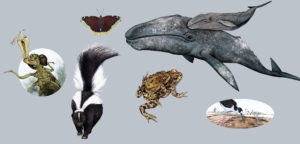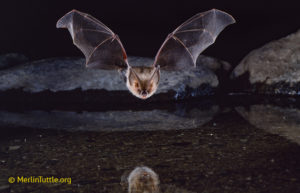My daughter and I were hiking in Sunol Regional Wilderness today and stopped by High Valley Pond to say hello to the Western Pond turtles. There were a handful of Common Whitetail dragonflies, most of whom were busy with dragonfly business and ignoring the turtles. One, however, seemed to be deliberately baiting the turtles – it would fly to a turtle swimming with just it’s head sticking out and whap the head with it’s abdomen, often resulting in the turtle trying to catch the dragonfly but ending in the turtle submerging at which point the dragonfly would pick a new victim. We were wondering what was really going on — do they try to deposit eggs on turtles? Thank you! -Melissa Grush, Union City
Intriguing behavior! It’s hard to say what might have been going on, but perhaps we can take a look at dragonfly behavior in general to come up with some possibilities. Common whitetail (Libellula lydia) belongs to the family of dragonflies called “skimmers,” and skimmers are the largest dragonfly family. Most of them feed from a low perch away from open water, such as a rock or log, foraying out from a suitable spot to catch an insect and then returning to the same spot over and over again. It’s possible that your common whitetail was simply looking for a perch and thought the turtle head sticking out of the water made for a good one. The tapping behavior could have simply been an attempt to see if the “perch” was solid, like a rock. Finding that it was not, the dragonfly simply went on to another possible perch location.
Dragonflies are food for all kinds of predators: fish, frogs, turtles and birds to name a few, so I’m not surprised that the turtle tried to nab the dragonfly. It also isn’t surprising that the dragonfly would attempt the same behavior over and over again. I don’t think they have much memory storage in that tiny brain — and 80% of their brain function is devoted to vision!
It wasn’t entirely clear whether the dragonfly in question was a male or a female common whitetail, so I can’t be sure if it was ovipositing. The sexes are different in appearance, with the male having the obviously white abdomen. As males mature they acquire pruinosity, a powdery white “bloom” that exudes from cuticle (the outermost covering of the insect), making it look chalky white or even pale blue. This is especially spectacular with whitetails.
The female’s abdomen is brown with white to pale yellow spots along each side. The wing pattern is also different, with the male having a black streak near the base of the wing and a large black band across the outer wings. The female has three dark spots on each wing — the same streak of black near the base of the wing, but a second spot near the center of the wing and the third on the tip of the wing, making her look almost like a 12-spotted skimmer.

The act of mating is the same with all dragonflies. Males spend a lot time patrolling for females. Skimmers defend a territory (usually a good spot for egg laying) keeping all other males away. When a mature female enters the territory, the male grabs her with his legs and then immediately attempts to clasp her head with the appendages at the end of his abdomen, called cerci. The male captures the female by inserting the cerci into the back of the female’s head. They then form a “wheel”, the female bringing the end of her abdomen up to the males sperm chamber which is under the thorax. Once the eggs are fertilized, then ovipositing, or egg-laying can begin.
Dragonflies have lots of different strategies when it comes to ovipositing. Most deposit their eggs in vegetation, others directly in the open water and sometimes in wet spots near water. Females that lay eggs into water will allow a cluster of eggs to form before she taps the water to release them. Those that lay eggs in vegetation have an ovipositor (a spike-like structure under the abdomen) to pierce the plant and lay eggs inside. Males generally hold on to the female while she is ovipositing so another male doesn’t come along and snatch her away. However, the male common whitetail is extremely territorial and will hover above the female while she is ovipositing, usually near floating vegetation, on clumps of mud, or on shiny surfaces.
I hope this information offers some clue as to what the Common Whitetail was doing. I personally like to sit quietly at the edge of a pond and observe dragonfly behavior. Even though dragonflies have excellent vision, if you are still, the dragonfly will ignore you and go about its business. By spending time doing this you can learn to tell the differences between males and females, see males perch or patrol for food, and if you are lucky, see a male capture a female and form a wheel, and then watch a female ovipositing.

Ask the Naturalist is a reader-funded bimonthly column with the California Center for Natural History that answers your questions about the natural world of the San Francisco Bay Area. Have a question for the naturalist? Fill out our question form or email us at atn at baynature.org!




-300x199.jpg)
-300x200.jpg)